November 14, 2006
Effects of troop numbers in Iraq
Back to the Stuntz paper for a moment, because it poses an interesting military-statistical question:
Consider these data: Between November 2004 and February 2005, according to the Brookings Institution's Iraq Index, the number of coalition soldiers in Iraq rose by 18,000. In that time, the number of Iraqi civilians killed fell by two-thirds, and the number of American troops wounded fell by three-fourths. The soldiers were soon pulled out; by the summer of 2005, American and Iraqi casualties rose again. Later that year, the same thing happened again. Between September and November of 2005, another 23,000 soldiers were deployed in Iraq; once again, both Iraqi and American casualties fell. In the early months of 2006, the number of soldiers fell again, and casualties spiraled up.
The picture is clear: More soldiers mean less violence, hence fewer casualties.
This is a graphical representation of what Stuntz is talking about. The blue bars are the variation in historical troop totals from the occupation-long mean of 161,000. The red bars are the variation from the mean in coalition fatalities by hostile causes in that month (34.1 per 100,000 troops is the average). If Stuntz's thesis had borne out up until now, whenever the blue bar is above the zero line (greater than average violence), the red bar should presumably be below it (fewer than average troops), and vice versa (ie, more troops equals less violence, less troops equals more violence):
Coalition hostile death rates per 100,000 soldiers per month compared to Coalition force level variations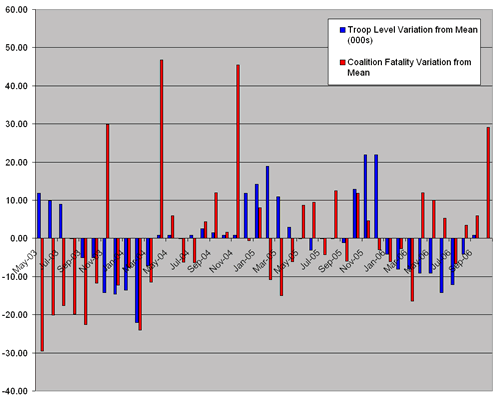
Looking at the blue bars, the graph shows that, as Stuntz says, we've basically had two "surges" of US and allied forces into Iraq since the occupation began -- January-February 05, and again in November-December 05 -- but it appears possibly with more mixed results than he's indicating above. In the early 2005 case, there at first does appear to have been a correlation between increased troop presence and a reduced level of violence in the spring of 2005 (even if Stuntz is cherrypicking his months a little in the quote above to maximize the effect); but in the second instance, the statistical evidence for any correlation seems less pronounced.
The correlation between periods where there was a reduced number of troops and an increase in violence is less clear: there are several months where the blue and red bars are both below the line, indicating a period where low violence and low troop levels coincided. There are even a couple points where an increase in coalition troop levels was simultaneous with an increase in violence (spring/04 and again in fall/06).
Correlation is not causation, of course. One obvious competing hypothesis would be that Iraq violence follows its own rhythms, and coalition troop levels have exerted a fairly minor effect. In fact, Iraq coalition fatalities seem to have developed a "double peak" annual cycle, with higher than average fatalities in the late fall, around Ramadan, and a second, smaller peak in the April period, with calmer periods in between in the winter and summer. There are obvious climatic and religious reasons this would be the case. The chart below shows average Coalition hostile fatalities by month, which illustrates the curve better:
Monthly averages of Coalition hostile fatalities since start of occupation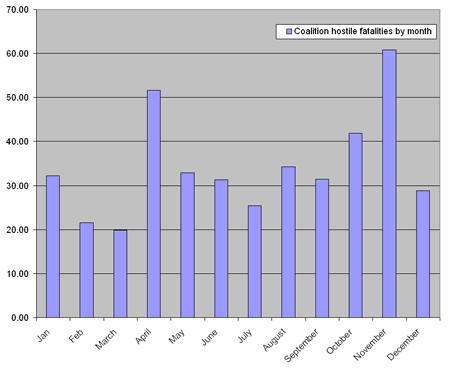
To extrapolate a calming effect due to troop increases, one could try subtracting out this seasonal variation in violence rates. The following graph attempts to correct in this fashion. In this graph, a red bar below the line in May, for instance, indicates a "calmer than average May." Just as with the previous graph like this, if increased troops lead to greater calm, and vice versa, the the blue and red bars should be mostly on opposite sides of the zero-line below:
Seasonally-corrected Coalition hostile death rates per 100,000 soldiers per month, compared to Coalition force level variations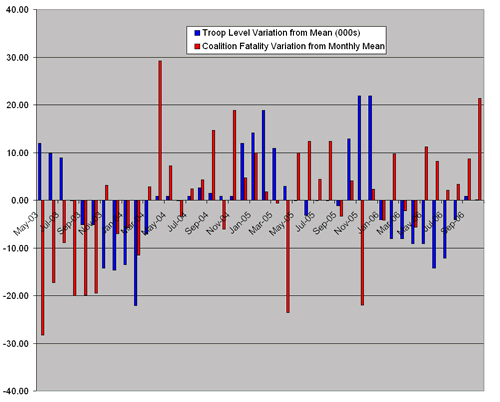
But again, it's not particularly clear cut. Some periods of the Iraq occupation seem to fit the Stuntz hypothesis, but others do not. Also note that the spring 2005 calming Stuntz suggested above seems a much less viable conclusion in this context: the relativized violence levels are not only higher than in the same season in other years, right in the period of a U.S. surge, but there is also no obvious difference in the relativized level of violence between the surge period and the summer immediately following, where troop numbers were back down close to the average level again. In short, early-to-mid-2005 by this measure was a more violent-than usual period for Coalition troops in Iraq apparently no matter how many troops were coming in or leaving.
It's not necessarily counterintuitive that more troops could increase violence levels, either. If the occupying troops are on the balance an irritant to the society being occupied, increasing their numbers could conceivably serve to increase the irritation. More troops also makes for more targets, an obvious shortcoming of the comparative method I'm using here, even if Coalition combat fatalities is a preferable measure of violent levels otherwise: I've attempted to correct a little by using Coalition violent fatalities per 100,000 rather than the simple total, throughout.
There simply may not be enough data to establish a statistical relation between troop levels and violence. Or there may not be one at all. The following scattergraph shows violence levels, defined by violent deaths of Coalition soldiers per 100,000 per month, relative to the average of violent deaths for that month (y-axis), directly against what the Coalition combat troop levels were in the same months (x-axis). If Stuntz's point is to hold, there would be a discernable downward sloping curve evident, presumably, as more troops in a given month resulted in less violence. Judge for yourself:
Total Coalition force levels (x) vs change in seasonally-corrected Coalition hostile deaths per month (y)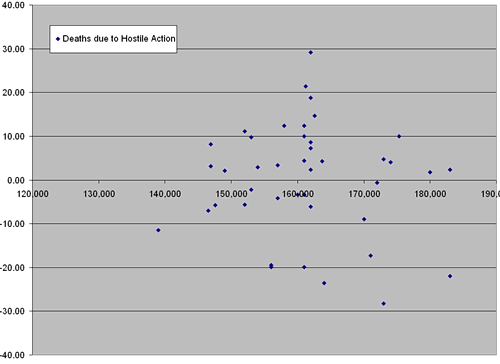
Finally, a supporter of the Stuntz thesis might argue that it was the effect of changing troop levels that would have the impact of calming or heightening tensions in an occupied country, not just the total: the surge or withdrawal would then have a delayed impact, one or more months after the troops arrive or depart. So here's a scattergraph of that, with the change in troop level in each month (x axis) compared to the change in violent Coalition fatalities in the same month (blue), and one month later (pink) on the y-axis. Again, for the Stuntz thesis to be valid, one should expect to discern a downward sloping curve, with the majority of points in the upper left or lower right quadrants here. Here, I don't believe there's a discernable correlation, but judge for yourself:
Changes in force levels (000s) (x) vs change in seasonally-corrected Coalition hostile death rates per month after 1 and 2 months (y)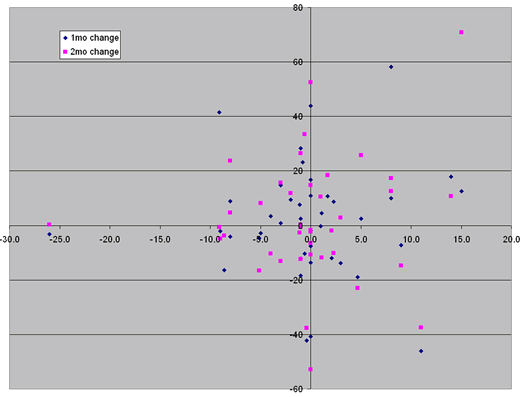
It should be obvious this is a fairly important question. If it can be established increased troop levels have been producing a positive effect on the security situation, that not only means that there is some hope for future stabilization through a troop increase, but that American forces have had and are having a net positive effect on Iraqi security levels now. If, on the other hand, no correlation between troop levels and violence levels can be established, the logical conclusion is American troops have been contributing very little to stabilizing the Iraqi situation, in any numbers. Regrettably for supporters of the Stuntz argument, given the statistical data to date, the latter seems the stronger conclusion.
See also Henley and Djerejian.
(Coalition force numbers from the Brookings Institution. Fatality numbers from iCasualties.org.)
Update: the other conclusion that one could draw from this is that no effects are discernible because the variation in troop numbers is so small, only plus/minus 20,000 or so. It's fair to say that the two 20,000 size surges in 2005 appear to have had no lasting effect on violence rates... therefore the prospects that another 20,000 increase (c. 180,000 Coalition forces combined) would achieve anything lasting seem dim. This would support the argument that only a major Western military intervention, on a scale that has not so far been seriously contemplated (190,000 troops or more in country, at least 30,000 more than there are now) would be required to accomplish anything different.
UPDATE: I continue this line of analysis, this time counting US wounded as well, here.
"endearingly macho" -- Mark Steyn
"wonderfully detailed analysis" -- John Allemang, Globe and Mail
"unusually candid" -- Tom Ricks, Foreignpolicy.com
May 2010
April 2010
March 2010
February 2010
January 2010
December 2009
November 2009
October 2009
September 2009
August 2009
July 2009
News:
The Globe and Mail
The Star
The Wash. Post
Opinion:
TNR
Slate
Washington Monthly
Rants:
Canadians
Penny
Janes
Cosh
The Hound
Coyne
Wells
Farrell, etc.
Steyn
Levant
Afghanistan
The Torch
Abu M.
Bill & Bob
Ghosts of Alex
Registan
Jari
Ink Spots
Ackerman
Kings
FRI
Embedded
Milnews.ca
Can-AFG
The Capt.
Etc.
TMLutas
Sullivan
Marshall
Kaus
Lileks
Reynolds
Welch
Farber
The Shark
Breen
Henley
Electrolite
Samizdata
Slotman
Simberg
Northrup
Bryant
Yglesias
Cole
Drum
Clients/Employers
(Past and Present):
U of T
Cdn. Forces
CG Magazine
LRC
Adrenaline Vault
